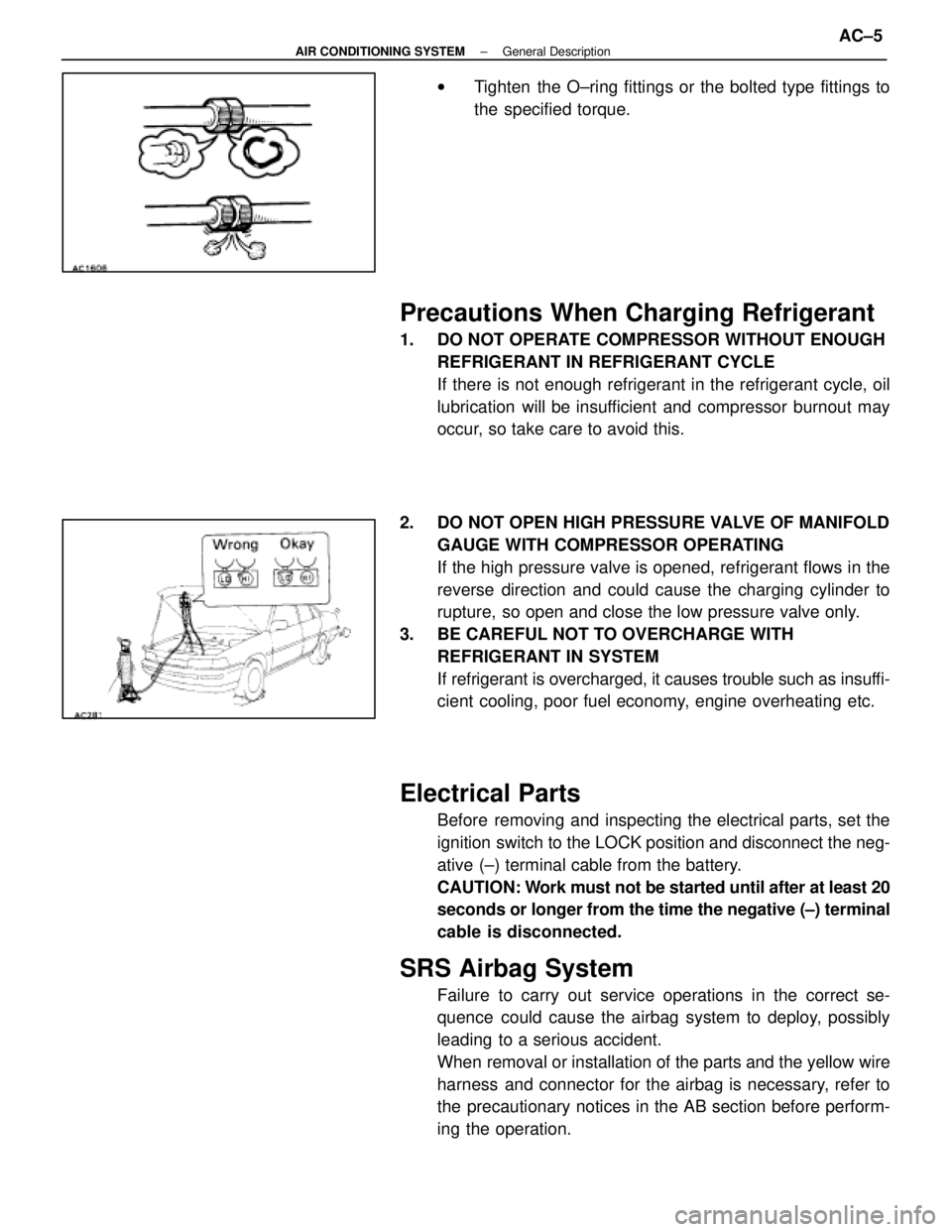Page 1 of 4087

ABBREVIATIONS USED IN THIS
MANUAL
ABS Anti±Lock Brake System J/B Junction Block
A/C Air Conditioner LED Light Emitting Diode
ALR Automatic Locking Retractor LH Left±Hand
APPROX. Approximation LHD Left±Hand Drive
A/T, ATM Automatic Transmission LLC Long Life Coolant (Year Around Coolant)
ATF Automatic Transmission Fluid Max. Maximum
BTDC Before Top Dead Center Min. Minimum
BVSV Bimetal Vacuum Switching Valve MP Multipurpose
CALIF. Vehicles Sold in California N Neutral
CB Circuit Breaker OD, O/D Overdrive
DOHC Double Over Head Cam O/S Oversize
DP Dash Pot P & BV Proportioning and Bypass Valve
ECT Electronic Controlled Transmission PCV Positive Crankcase Ventilation
ECU Electronic Controlled Unit PS Power Steering
EFI Electronic Fuel Injection RH Right±Hand
EGR Exhaust Gas Recirculation RL Rear Left
ELR Emergency Locking Retractor RR Rear Right
EPR Evaporator Pressure Regulator RR, Rr Rear
ESA Electronic Spark Advance SRS Supplemental Restraint System
EVAP Evaporative (Emission Control) SSM Special Service Materials
EX Exhaust (manifold, valve) SST Special Service Tools
Ex. Except STD Standard
FIPG Formed in Place Gasket SW Switch
FL Front Left TDC Top Dead Center
FL Fusible Link TDCL Total Diagnostic Communication Link
FPU Fuel Pressure Up Temp. Temperature
FR Front Right TRAC Traction Control System
FR, Fr Front TWC Three±Way Catalyst
HAC High Altitude Compensation VSV Vacuum Switching Valve
IG Ignition VTV Vacuum Transmitting Valve
IN Intake (manifold, valve) w/ With
INT Intermittent w/o Without
ISC Idle Speed Control
IN±34±
INTRODUCTION Abbreviations Used in This Manual
WhereEverybodyKnowsYourName
Page 15 of 4087

PRECAUTIONS FOR VEHICLES
EQUIPPED WITH A CATALYTIC
CONVERTER
CAUTION: If large amounts of unburned gasoline flow into the
converter, it may overheat and create a fire hazard. To prevent
this, observe the following precautions and explain them to
your customer.
1. Use only unleaded gasoline.
2. Avoid prolonged idling. Avoid running the engine at idle speed for more than 20 min-
utes.
3. Avoid spark jump test. (a) P e r f o r m s p a r k j u m p t e s t o n l y w h e n a b s o l u t e l ynecessary. Perform this test as rapidly as possible.
(b) While testing, never race the engine.
4. Avoid prolonged engine compression measurement.
Engine compression tests must be done as rapidly as pos-
sible.
5. Do not run engine when fuel tank is nearly empty. This may c ause the engine to misfire and create an extra load
on the converter.
6. Avoid coasting with ignition turned off and prolonged braking.
7. Do not dispose of used catalyst along with parts contaminated with gasoline or oil.
IN±12
±
INTRODUCTION Precautions for Vehicles Equipped with a Catalytic
Converter
WhereEverybodyKnowsYourName
Page 46 of 4087

wTighten the O±ring fittings or the bolted type fittings to
the specified torque.
Precautions When Charging Refrigerant
1. DO NOT OPERATE COMPRESSOR WITHOUT ENOUGH
REFRIGERANT IN REFRIGERANT CYCLE
If there is not enough refrigerant in the refrigerant cycle, oil
lubrication will be insufficient and compressor burnout may
occur, so take care to avoid this.
2. DO NOT OPEN HIGH PRESSURE VALVE OF MANIFOLD GAUGE WITH COMPRESSOR OPERATING
If the high pressure valve is opened, refrigerant flows in the
reverse direction and could cause the charging cylinder to
rupture, so open and close the low pressure valve only.
3. BE CAREFUL NOT TO OVERCHARGE WITH REFRIGERANT IN SYSTEM
If refrigerant is overcharged, it causes trouble such as insuffi-
cient cooling, poor fuel economy, engine overheating etc.
Electrical Parts
Before removing and inspecting the electrical parts, set the
ignition switch to the LOCK position and disconnect the neg-
ative (±) terminal cable from the battery.
CAUTION: Work must not be started until after at least 20
seconds or longer from the time the negative (±) terminal
cable is disconnected.
SRS Airbag System
Failure to carry out service operations in the correct se-
quence could cause the airbag system to deploy, possibly
leading to a serious accident.
When removal or installation of the parts and the yellow wire
harness and connector for the airbag is necessary, refer to
the precautionary notices in the AB section before perform-
ing the operation.
±
AIR CONDITIONING SYSTEM General DescriptionAC±5
WhereEverybodyKnowsYourName
Page 462 of 4087
FUEL LID
Fitting Adjustments
HINT: Adjust the fuel lid according to the following meth-
od.
ADJUST FUEL FILLER OPENING LID Loosen the two screws and adjust the lid as shown.
Fuel Lid
COMPONENTS
BO±106±
BODY Fuel Lid (Fitting Adjustments)
WhereEverybodyKnowsYourName
Page 577 of 4087
FUEL LID OPENER SYSTEM
Parts Location
Wiring and Connector Diagrams
±
BODY ELECTRICAL SYSTEM Fuel Lid Opener SystemBE±191
WhereEverybodyKnowsYourName
Page 578 of 4087

Parts Inspection
(Fuel Lid Opener Switch)
REMOVAL AND INSTALLATION OF FUEL
LID OPENER SWITCH
REMOVE AND INSTALL FUEL LID OPENER SWITCH(a) Remove No. 1 lower finish panel.
(See Instrument Panel on page BO±113)
(b) Remove the key cylinder, then remove the fuel lid opener
switch assembly from the pad.
(c) Install the opener switch assembly and key cylinder to
the pad.
(d) Install the No. 1 lower finish panel. (See Instrument Panel on page BO±116)
INSPECTION OF FUEL LID OPENER
SWITCH
INSPECT SWITCH CONTINUITY
(a) Check that there is continuity between terminals with the
switch ON (Lever pulled).
(b) Check that there is no continuity between terminals with
the switch OFF (Lever free).
If continuity is not as specified, replace the switch assembly.
(Fuel Lid Opener Solenoid)
REMOVAL AND INSTALLATION OF FUEL
LID OPENER SOLENOID
REMOVE AND INSTALL FUEL LID SOLENOID (a) Disconnect the connector from the solenoid.
(b) Open the fuel lid and remove the solenoid lock nut, thenremove the solenoid.
(c) Install the solenoid in place with the lock nut.
(d) Connect the connector to the solenoid.
INSPECTION OF FUEL LID OPENER
SOLENOID
INSPECT SOLENOID OPERATION (a) Apply battery voltage to the terminals.
(b) Check that the solenoid operates in the open direction.
If operation is not as specified, replace the solenoid.
BE±192
±
BODY ELECTRICAL SYSTEM Fuel Lid Opener System
WhereEverybodyKnowsYourName
Page 579 of 4087
Troubleshooting
You will find the cause of trouble more easily by properly using the tabl\
e shown below. In this table, the numbers
indicate the order or priority of the causes of trouble. Check each part\
in the order shown. If necessary, replace
the part.
See page
BE ± 4, 20BE ± 192BE ± 192
±
Trouble
Part Name
DOOR FuseFuel Lid Opener Switch
Mirror SwitchFuel Lid Opener SolenoidWire Harness
Fuel lid opener system does not operate1234
±
BODY ELECTRICAL SYSTEM Fuel Lid Opener SystemBE±193
WhereEverybodyKnowsYourName
Page 645 of 4087
31NoiseNOISE PRODUCED WHEN ENGINE STARTS
Whistling noise which becomes high±pitched when
accelerator strongly depressed, disappears shortly
after engine stops.Whining noise occurs when A/C is operating.
Scratching noise occurs during sudden accel-
eration, driving on rough roads or when ignition
switch is turned on.
Clicking sound heard when horn button is
pressed, then released. Whirring/grating sound
when pushed continuously.
Murmuring sound, stops when engine stops. Tick±tock noise, occurs in coordination with
blinking of flasher.
Noise occurs during window washer operation.Scratching noise occurs while engine is running,
continues a while even after engine stops.Scraping noise in time with wiper beat.
Other type of noise. Alternator noise.
A/C noise.
Fuel gauge noise.
Horn noise.
Ignition noise. Turn signal flasher noise.
Washer noise. Water temp. gauge noise.
Wiper noise.
±
BODY ELECTRICAL SYSTEM AUDIO SYSTEMBE±259
WhereEverybodyKnowsYourName